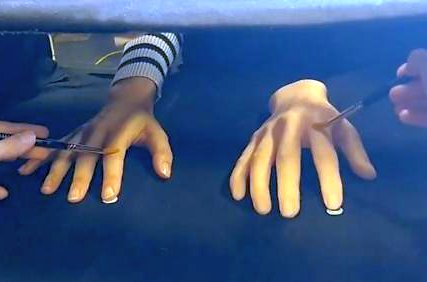The classic psychological experiment called the Rubber Hand Illusion is flawed, says a study. Researchers from the University of Sussex say the study is not fit-for-purpose. Their paper is published in the journal Collabra: Psychology.
Rubber Hand Illusion
The Rubber Hand Illusion is where a subject’s concealed hand and a fake rubber hand are stroked in sync with each other, usually with a brush. After a while, the subject begins to perceive that he has ownership of the rubber hand, and it is part of his body. This famous experiment has been cited in more than 5,000 articles since it was first documented more than 20 years ago.
Just Hypnosis?
The problem is, according to Peter Lush, the author of the paper, control conditions typically used in the Rubber Hand Illusion do not do they job they need to do. In other words, the results can be attributed to imaginative suggestion, or hypnosis.
“The Rubber Hand Illusion is a cornerstone of contemporary consciousness science. It has been extended to almost any body part imaginable and investigated in just about any clinical disorder you can imagine.
“This paper prompts the reinterpretation of all this work, and other work which uses the same control methods, such as the full body illusion, the out of body illusion and the enfacement illusion. Existing claims that the rubber hand illusion is not a suggestion effect are invalid, and therefore it is possible that existing reports of the rubber hand illusion are entirely attributable to suggestion effects,” said Lush.
Impact of Suggestions
In a previous study by Lush and his colleagues, a strong correlation was shown between response to the Rubber Hand Illusion and response to imaginative suggestion. That study involved 353 participants.
In the current study, it was shown that response to the Rubber Hand Illusion is partially or entirely a suggestion effect. The participants were given information about the Rubber Hand Illusion procedure in the form of written text and a video (1-minute long). They then filled out a questionnaire about how they expect they would respond in the Rubber Hand Illusion if they were a participant.
The results were eye-opening. Whether the participants were answering about “experimental” conditions or “control” conditions related to the Rubber Hand Illusion, they expected the same pattern of results. In other words, suggestion had a role in some way with the results the participants were giving.
Not Fit For Purpose
The Rubber Hand Illusion has been documented for over 20 years and cited in more than 5,000 articles. It has been used in a large numbers of studies related to psychology and body image. Now it seems the results may be due to, partially or entirely, a suggestion effect. This means that it is not fit for purpose because demand characteristics have not been adequately controlled.
Importance of Control Group
It remains to be seen how the findings is this study will impact the related fields. One thing this study has brought into focus is that good scientific studies need robust controls.

